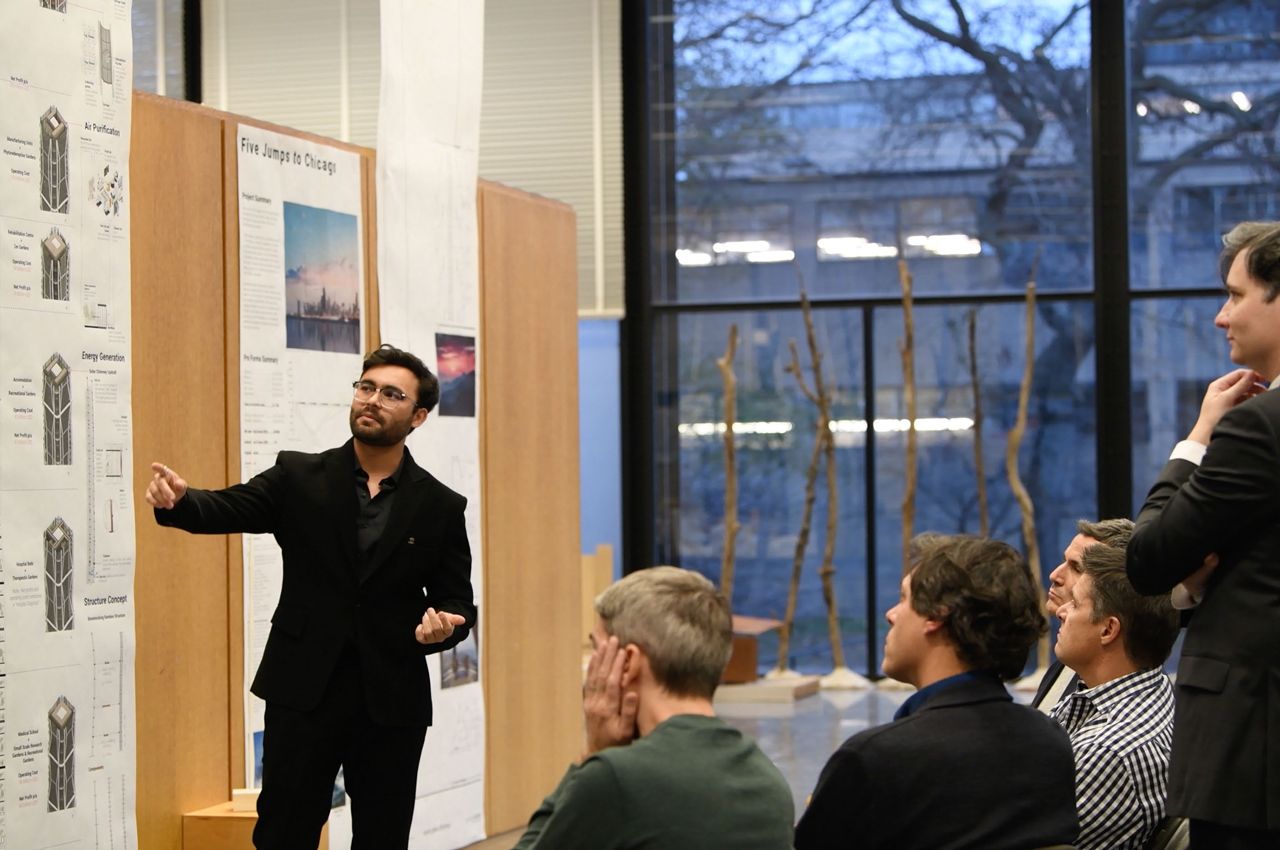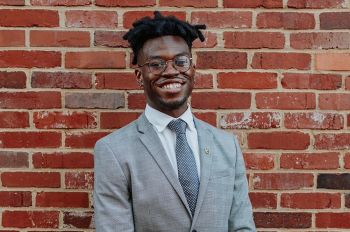Rethinking the High-Rise “Pro Forma”

Commercial office. Multi-family residential housing. Architects have been incorporating these ubiquitous uses into high-rises for decades.
But this year—with the intensely integrated input of a globally renowned, Chicago-based architectural institution—one of Illinois Institute of Technology’s most unique graduate degree programs is tackling new, sustainable uses for high-rise buildings at a time when city leaders across the country are searching for new solutions to fill them.
For the 2023–24 academic year, Skidmore, Owings & Merrill has led the design studio for the College of Architecture’s Master of Tall Buildings and Vertical Urbanism (M.TBVU.) program, a multidisciplinary graduate degree program that was developed through a partnership with the Council on Tall Buildings and Urban Habitat.
“The students are tackling what is probably the most existential challenge facing the tall building typology since its inception,” says Scott Duncan, a design partner at SOM who is one of three leaders at the firm involved in the studio. “Through the studio, they are developing extraordinary design solutions for how tall buildings remain relevant in a world of carbon reduction goals, remote working practices, and a questioning of the very viability of our downtowns.”
The M.TBVU. program was created to explore sustainability in the face of exponential urban growth. Rather than design future tall buildings to accommodate their traditional office/residential utilizations, the program encourages students to develop alternative designs that can accommodate both their high-density usage and the need to ethically sustain their environment, both locally and globally.
Enter SOM’s Nova Pro Forma studio—named by combining the Latin words “nova,” meaning new, and “pro forma,” or “as a matter of form,” often used to describe something done a certain way because it’s always been done that way. The “pro forma” of a building also refers to its business case for existing, including the financial model that balances its large number of floors and square footage with its costs and revenues.
“The nova portion is very important to the title—it’s rethinking ideas,” says SOM associate principal Jason Fisher, who is also involved in the studio. “The students are asked to move beyond the typical formula of tall buildings. The financial aspects of that are also unknown. They’re asked to gather specific assumptions of how much money they could make, and provide that business model.”
These proposals often require much research and extrapolation.
“Trying to determine how much [new sustainability ideas] are worth to the market is a new thing,” Fisher adds. “The ‘nova’ portion [of the studio] is true across building typologies, across how it operates financially, and how you pitch it to the public.”
Jorge Rovira, another SOM associate principal involved in leading the studio, says he has been impressed with students’ ability to be both creative and pragmatic. “It was fascinating, the [students using] down-to-earth calculations, using purely numbers,” Rovira says. “It was a pragmatic approach, while at the same time being very ambitious.”
Student proposals included coupling data centers with a vertical arboretum or vertical farming; a vertical cement plant and thermal battery system capable of storing enough energy to power Austin, Texas for a week; and a coastal skyscraper that functions as an algae farm.
Many focused on health care: A research hospital combined with an opium poppy farm. A medical research center powered by a nuclear reactor. An educational research hospital that cultivates high-altitude medicinal plants for pharmaceuticals. Carbon-capture technology snagged the imaginations of three students: one proposal sought to create a carbon-capture stack that also uses gravity battery technology to produce electricity; another converts absorbed carbon dioxide into e-methanol and biodiesel, while a third aims to clean river water and convert the carbon dioxide to ethanol.
Rovira notes that some student ideas were surprisingly similar to those that SOM architects were examining internally. “There’s a really strong connection between what they’re designing and what we’re developing in the firm. Some were unexpected, some were not,” he says.
SOM’s input in the course was extensive: The firm not only supplied three instructors, they also brought in additional experts to advise students along the way, including a renowned structural engineering expert, their sustainability team, and a quality control team.
“I remember very distinctly William Baker [an internationally acclaimed structural engineering expert who engineered the world’s tallest building, the Burj Khalifa in Dubai] would make a student stand up, push them, and say, ‘if you’re this tall you need this much stability,’” says Fisher. “It was kind of amazing, his ability to be in the process with them, which is different from just bringing in someone for the final review.”
Allison Drooger (M.TBVU. 1st Year)—one of four students who also received a SOM internship after the fall studio—says the program “opened doors to remarkable opportunities in tall building design, offering a fresh perspective on urbanism. This ongoing education continues to shape my understanding of how we as designers can create a more enjoyable world for others through design.”
The benefits work both ways, Fisher says. “We’ve done so many of the standard high-rise buildings. We see in the future our work changing. When you bring those prompts to the students, there’s a freedom and energy to it that we obviously benefit from.”
The SOM professionals highlighted how the COVID-19 pandemic has bolstered a need for new “pro forma” ideas by “radically transforming” the primary functions of high-rises, particularly in urban cores. That transformation, they note in a project summary, is due to “less demand for office space due to remote work practices, and the attendant downward pressure on living in the urban core [in addition to] a heightened awareness about the importance of energy efficiency and other forms of environmental sustainability.”
As an example, Chicago’s State Street—a high-density corridor in the heart of the city’s downtown loop—had the highest rate of vacancy on record in February 2024, according to news reports, amid an overall downtown vacancy rate of 23.5 percent. Business leaders are now working to come up with alternate uses for the spaces beyond simple commercial, residential, and retail purposes.
Students in the spring semester—who focused on rehabbing existing buildings, rather than designing new ones—traveled not only to downtown Chicago, but were also flown to New York and San Francisco to explore builds in urban cores that have seen increased vacancy rates.
“Our students in the M.TBVU. program have embarked on an unparalleled journey of innovation and discovery,” Rowe Family College of Architecture Dean Endowed Chair Reed Kroloff says. “Their dedication and creativity in addressing the complexities of tall building design and urban density underscore not only their potential, but also the program’s unique capacity to shape the architects of the future.”
Adds Rovira, “SOM and Illinois Tech have always been linked in research and innovation. What we wanted to do was try to renew it.”



